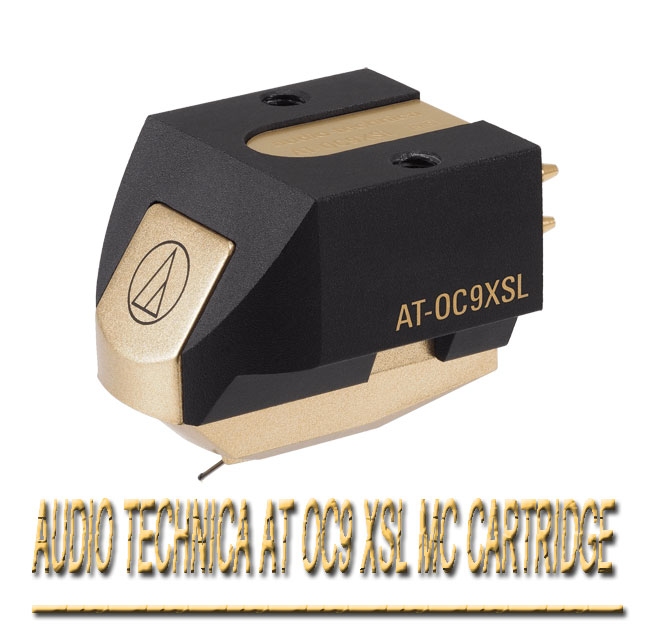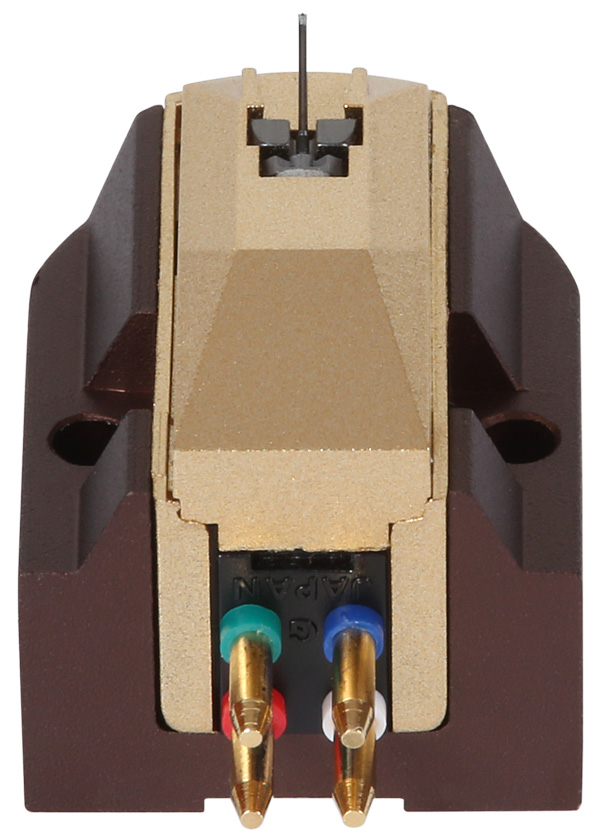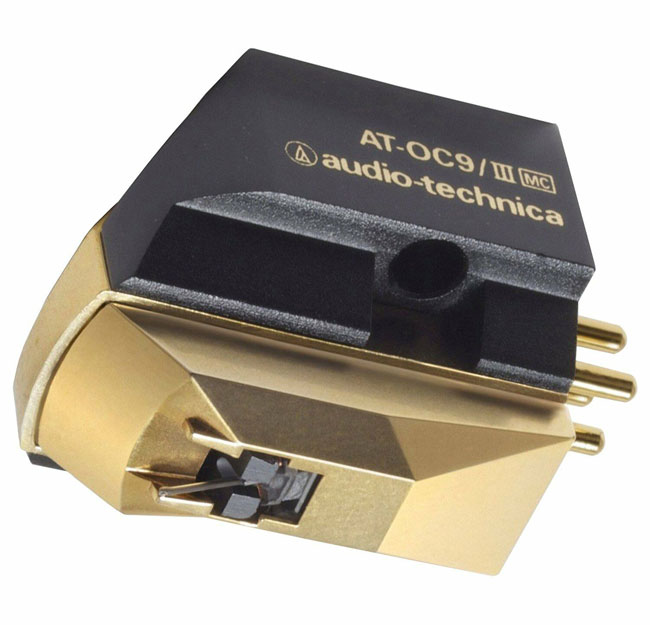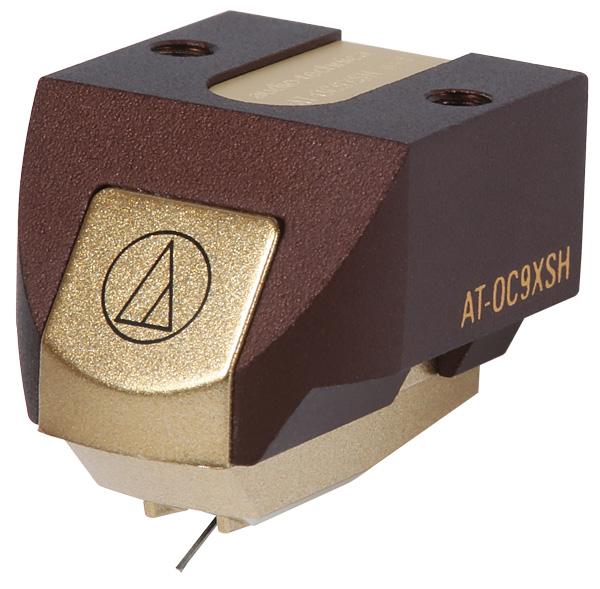Audio Technica AT OC9 XSL MC Cartridge by Paul Szabady

Reviewing the Graham Slee Accession MC phono stage earlier this year (see: here), closely followed by the Origin Live Discovery 2 MM/MC stage (see: here), triggered a renewed interest in low-output moving-coil cartridges. The Accession’s and Discovery’s ability to extract beautiful sonics and intensely communicative music from some of my older and more recalcitrant LOMC’s had me re-thinking the potential of the cartridge type.
I never was a doctrinaire devotee of the moving-coil type’s pre-eminence: 25+ years’ experience in the audio retail trade, coupled then with 20 years reviewing audio products. Having been exposed to an extensive range of moving-coil cartridges left me ultimately unsatisfied with most of them. Though undeniably capable of stupendously spectacular sonics, I found far too many musically only so-so. Given the greater difficulty and far greater financial commitment necessary to use a LOMC in one’s front-end, any sonic and musical inaccuracies were also much harder to gloss over. It’s far easier to forgive a cheap cartridge’s flaws than those of a mega-priced one.
Historically, most available LOMC’s tended to situate themselves into two different camps – far too many LOMC’s produced a severely rising high-frequency response. In contrast, many of the exotic “artisanal” types made their euphonic sound aided by an equally severe high-frequency droop. The subsequent and on-going development of the LOMC has seen the attempt of the two camps to eliminate this response irregularity. The LOMC has also struggled with high-price (obscenely high in some cases,) finding compatibility with readily available and affordable tonearms, and matching to phono preamplifiers that could accurately deal with the MC’s low output.


The new AT OC9 XSL is the top cartridge in Audio Technica’s re-vamped OC9 low-output moving-coil cartridge line, the “X” identifying the current incarnation. The OC9 originally appeared in the mid-1980s and had become somewhat of a benchmark, offering extremely sophisticated design and high-performance constituent parts at a readily affordable price. The OC9 has gone through four iterations since then.
The current OC9 X line reflects the thinking/marketing of Audio Technica’s current AT VM95 budget moving-magnetic line, in that it offers a range of models varying substantially in price and most significantly in stylus type. However, being low-output moving-coil designs with fixed styli/cantilevers precludes the user-friendly and straightforward upgrade path of changing stylus types that the AT VM95 series offers.
There are five models in the current OC9X line, starting at a low $239 for the bonded-elliptical stylus-ed OC9 XEB. A nude elliptical stylus version – OC9 XEN – adds another $110. The top 3 models offer line-contact styli and gain boron cantilevers: the Micro-Line OC9 XML at $550, the Shibata-tipped OC9 XSH at $650, and the $729 XSL reviewed here.
I’m intimately familiar with three of the four previous iterations of the OC9 line and still run the OC9 ML and OC9 ML III occasionally, mostly on my two elderly but modified Linn Sondek LP12 turntables. The Micro Line stylus has proven to be a long-life stylus shape in my personal use, aided by my judicious use of LAST and Lyra stylus treatments. While offering all the sonic benefits of the line-contact type, the ML stylus offers striking longevity because normal wear doesn’t significantly alter its original stylus shape. My now ancient OC9ML still sounds fresh as new. Thus, the $550 OC9 XML would seem to be the sweet-spot budget choice in the new OC9X line. Still, I decided to review the top-of-the-line XSL to hear how Audio Technica’s even more exotic stylus profile, also used in Audio Technica’s flagship ART 1000 cartridge, performs.
 Prepare a checklist for all the technical features that you want a phono cartridge to possess, and the AT OC9 XSL checks them all off, running the gamut with impressive technical and mechanical specifications. Its strictly electrical demands – 0.4 mV output and 100 Ohm loading – means it will mate with most moving-coil phono stages, including most older ones, which used a 100 Ohm load as standard. Stylus compliance means the cartridge will work with the dominant medium mass tonearms available today. Its boron cantilever and exotic line-contact stylus, mated to its affordable price, let the OC9 XSL stand out as the most technically sophisticated phono cartridge in its price range. Only the absolute need to adjust the tonearm’s height to optimize VTA/SRA introduces potential difficulties for end-users.
Prepare a checklist for all the technical features that you want a phono cartridge to possess, and the AT OC9 XSL checks them all off, running the gamut with impressive technical and mechanical specifications. Its strictly electrical demands – 0.4 mV output and 100 Ohm loading – means it will mate with most moving-coil phono stages, including most older ones, which used a 100 Ohm load as standard. Stylus compliance means the cartridge will work with the dominant medium mass tonearms available today. Its boron cantilever and exotic line-contact stylus, mated to its affordable price, let the OC9 XSL stand out as the most technically sophisticated phono cartridge in its price range. Only the absolute need to adjust the tonearm’s height to optimize VTA/SRA introduces potential difficulties for end-users.
Installation was far more comfortable than the older series of OC9’s, the new treaded cartridge-top holes, and the supplied non-magnetic bolts and screw-driver making it just a few minutes work, even on arms that do not have detachable headshells. A useful stylus guard helped damp installation fear. I set tracking to the mid-point of Audio Technica’s recommendation at 2 grams. I used Soundsmith’s novel method of setting anti-skate, fortuitously, as the OC9XSL was revealing anti-skate settings. I set the arm tube/headshell parallel to the record, as per AT’s recommendation, and then used the spacer shims from my Ringmat Record Support System to fine-tune the VTA/SRA. I found the XSL stylus to be far trickier and far pickier regarding vertical-tracking angle/ stylus-rake angle adjustment than the ML stylus profile. I’ve always used a very slightly negative arm orientation (arm tube tilted somewhat toward the arm pivot) with previous Audio Technica OC9ML cartridges. Still, the XSL stylus turned nasty with even slight errors. Be prepared to spend some time (maybe a lot of time) getting this adjustment just right.
The OC9 XSL began to settle in at about 20 hours of play, and I re-checked set-up at that point.
I waited until 50 hours before believing what I was hearing, as some of the rougher and coarser sounds the OC9XSL made during its break-in process almost had me giving up on it. Patience was richly rewarded.
The evolution of the OC9 series shows an attempt to produce a more neutral frequency response, each successive iteration lessening to some degree the original’s rising high-frequencies. The OC9 XSL continues on this path. The extended high frequencies are all still there, in all their glory of “air,” detail, and clarity, but now possess a subtle, nuanced, and sophisticated refinement without exaggerating some of the earlier OC9 versions. I find this improvement extremely welcome as the rising high-frequency response of many older MC designs has always been my bete noire of the moving-coil type.
 If one were to summarize the OC9 XSL’s performance, high-resolution and high-detail would raise no contradiction. Calling it ultra-resolution and ultra-detailed would not be hyperbolic. The cartridge sounds incredibly fast, with extremely accurate tracking of the complete transient envelope of each note: attack, sustain, and decay are exemplary. Matching its incredible speed is its equally impressive ability to stop instantaneously. I could detect no blurring, smearing, or ringing.
If one were to summarize the OC9 XSL’s performance, high-resolution and high-detail would raise no contradiction. Calling it ultra-resolution and ultra-detailed would not be hyperbolic. The cartridge sounds incredibly fast, with extremely accurate tracking of the complete transient envelope of each note: attack, sustain, and decay are exemplary. Matching its incredible speed is its equally impressive ability to stop instantaneously. I could detect no blurring, smearing, or ringing.
This transient accuracy also benefits the space, timing, and silence between notes, directly leading to an excellent depiction of rhythm, melodic flow, timing, punctuation, and dynamic variation. The result is a direct and vividly clear communication of musical performance and expression. The XSL excels (pun intended) at portraying volume differences between lead and accompanying instruments, as it does with minute volume changes within a given instrumental line. Its way with low-level detail and overall silence at the lowest extremes of the dynamic range envelope is noteworthy as its ability to instantly move to large dynamic events. Large bass dynamics are punchy, focused, and controlled, with no over-hang or blurring.
The OC9 XSL’s transient integrity also aids in its excellent recreation of depth of instrument placement on the soundstage while also ensuring very clear instrument outlines.
Soundstage portrayal was wonderfully literal and directly coupled to the recording. The OC9 XLS was able to produce the sound of the instrument rising and falling within the ambiance of its recording site – an excellent test of ultra-resolution.
The OC9 series has always been extremely chameleon-like in their sonic performance, varying considerably (and often in completely contradictory ways) with differing turntables, arms, and phono stages, not to mention associated amplification and loudspeakers.
This is, of course, true for all LP playback products: one can only experience them in situ and context.
Heard through enough different Front-End components; however, one can begin to perceive a sonic signature. The OC9 XSL presents a tonal balance that does little editorializing – it doesn’t sound artificially warmly-colored, nor does it sound falsely clear. Its intense speed, clarity, control, and resolution allows analytic sound and music perception without enforcing it: one can focus on parts of the recording at will, without having parts of the spectrum thrust at one. One can just easily switch to holistic listening – listening to the forest and to the trees – and comprehend both simultaneously.
The OC9XSL was extremely quiet in the groove and didn’t exaggerate LP surface imperfections.
Once an LP has been wet cleaned (I’ve used the Disc Doctor system, which doesn’t require a vacuum record-cleaning machine, for over 25 years,) and when humidity levels are high enough in the listening room to not exacerbate static-electricity generation, most LP noise is due to physical surface damage to the vinyl itself (assuming, of course, that one has used a carbon-fiber brush to clean loose surface debris off the record just before play.) Lateral scratches across the record surface and conchoidal fractures in the groove wall itself (the equivalent of pot-holes in road surfaces) are the sources of the most obvious of record imperfections – the dreaded pops and ticks. Since these groove fractures generate extremely high transient spikes when tracked, you can tell a lot about an Analogue Front-End by how well it copes with these difficulties. The cartridge, tonearm, and phono stage play equal roles here. Their ability to cope with intense transient spikes without overloading and resonating/ringing determine how the system deals with these extreme record imperfections. The OC9XSL coped with this damage as well as any I’ve ever heard at any price. Most impressive.
The cartridge’s detailed accuracy also reveals the condition of used LP’s readily and depicts the quality of the pressing and of the recording art/technique in general.
Record collectors and LP connoisseurs will be well pleased.
 I was very pleasantly surprised (indeed over-joyed) with the OC9 XSL performance with Classical music and with unamplified music in general. Audio Technica’s entire range of phono cartridges has always had a strong positive reputation among Rock, Jazz, and popular music listeners in general, but the true Acid Test for sonic accuracy remains the Classical orchestra.
I was very pleasantly surprised (indeed over-joyed) with the OC9 XSL performance with Classical music and with unamplified music in general. Audio Technica’s entire range of phono cartridges has always had a strong positive reputation among Rock, Jazz, and popular music listeners in general, but the true Acid Test for sonic accuracy remains the Classical orchestra.
The varied and complex overtone structures of each member of each choir of the orchestra, the complexity and density of scoring, and recording techniques that genuinely attempt to recreate the illusion of a live event place demands on cartridge performance that other types of music rarely require.
Since the tonal balance of the OC9 XSL doesn’t add any artificial ‘warmth’ to the midrange, the cartridge’s ability to capture the unique sonic signature of each instrument is genuinely exceptional. Identifying each member of the strings, woodwinds, brass, and percussion was as easy and as literal as visually augmented live performance. I found myself luxuriating in the bassoon-iness of that instrument, swooning with violin tone, and hearing the rearward-facing bell of the French horn bouncing off the recording venue’s back wall.
The perceptual ease of immediately identifying What is making a sound and exactly Where that sound is located cuts the amount of perceptual energy usually wasted in listening to near zero, allowing one to fully focus on the music and to respond to its artistic intent.
And it is in music-making that the OC9 XSL truly shines. One of the big disappointments and frequently voiced criticisms of some ultra-high-resolution, “High-End” systems is that they tell you everything about a recording except for what the music means. Common to Audio Technica’s products through their history has been their adeptness at rhythm, drive, and timing – the communication that the performers are playing together for an artistic reason. The OC9 XSL is that rare component that uses ultra-resolution, ultra-detail, and ultra-clarity, fully allied to the demands of musical communication. Applause is due; given its affordable price, a standing ovation is appropriate.
I used the Origin Live Resolution MK4 turntable with Origin Live Enterprise 3C tonearm for the bulk of my auditioning, alternating between the Graham Slee Accession MC and Origin Live Discovery 2 phono stages. These drove a Prima Luna Dialogue tube line stage, which then fed the antique Stewart Hegeman-designed, wide-bandwidth EICO HF89, producing 50 Watts/channel from 6CA7 (EL34) output tubes. The speakers were the Sound Lab Dynastats, my speaker reference for 27 years now.
 This system allowed me to test for the ultimate capabilities of the OC9 XSL, which I supplemented by also listening to various other phono stages. These included the Pure Sound P10 tube MM with Graham Slee’s Elevator EXP moving-coil pre-pre amp or Audio Technica’s Signet MK10T SUT, EAR 834P, an original Musical Surroundings Phonomena, and a Graham Slee Reflex M w/Elevator EXP.
This system allowed me to test for the ultimate capabilities of the OC9 XSL, which I supplemented by also listening to various other phono stages. These included the Pure Sound P10 tube MM with Graham Slee’s Elevator EXP moving-coil pre-pre amp or Audio Technica’s Signet MK10T SUT, EAR 834P, an original Musical Surroundings Phonomena, and a Graham Slee Reflex M w/Elevator EXP.
While the OC9 XSL sound did change through these additional phono stages, the cartridge didn’t prove to be neurotic about phono stage matching, demanding neither tube nor solid-state particularly. Its high detail and clarity were readily perceptible through all of them, as were its excellent timing and music skills. Most phono stages say roughly in the cartridge’s price range ($729) might not reveal all of its potentials, possibly smearing and blurring its ultimate resolution.
The relatively reasonable price of the OC9 XSL might also tempt one to use it in a mid-range priced/quality table. Here the same potential problem arises, as the weakest links in these tables are typically their tonearms. The exceptions are the Regas, but their arm mounting arrangements preclude easy and incremental arm-height changes. Owners of medium-range tables should be prepared to devote the additional effort to fine-tune the OC9 XSL’s VTA/SRA and should also be ready to accept the fact that even exactly set-up, their table/arm won’t reveal all the XSL’s potential.
Since not many users will be using an ‘ultimate’ turntable/arm set-up with this cartridge (though I would highly encourage it), I also auditioned the OC9 XSL in two other tables: an Origin Live Aurora MKII w/ OL’s Onyx or Silver II tonearm (circa $2000-2500 total), and an OL DC-motored, a modified Linn Sondek LP12 w/ OL upgraded RB 250 arm. I also inserted these tables into two other systems in 2 other rooms, running more conventional dynamic-coil loudspeakers: the budget Monitor Audio Bronze 5 and the Harbeth P3 ESR w/ SVS SB 2000 subwoofer.
The OC9’s simpatico mating with the Linn Sondek LP12 has a long and happy history, and the OC9 XSL continues that tradition. The cartridge’s excellent timing, rhythm depiction, and overall music-making abilities complement the LP12’s signature strengths. The Origin Live Aurora, now in MK4 form, was even better in rhythm, boogie factor, sound-staging, and overall resolution and music-communication.
A ‘full Monty’ Aurora MK4 -with OL’s Upgrade transformer and Multi-layer platter options, mated with an OL Zephyr tonearm would be my first recommendation for those moving out of mid-level turntables.
Using dynamic-coil loudspeakers in comparison to the electrostatic Dynastat resulted in a noted diminution of ultimate clarity and resolution, as would be expected. It’s hard to match the speed and low distortion of an electrostatic speaker. Still, I found little to criticize with the dynamic-coil speakers I used. I would, however, avoid using the XSL with speakers with a dumbed-down high-frequency response designed to flatter digital playback.
I’ve always focused on finding ‘do-it-all’ components during my long experience in audio retailing and reviewing – items are uncompromised in all essential sonic and music-making aspects and thus make further upgrades seem questionable. Think ‘gilding the lily’ and ‘point of diminishing returns.’ The Audio Technica AT OC9 XSL strikes me as just that sort of successful ‘do-it-all’ phono cartridge. Its $730 price makes it a supreme bargain. But it may also be its Achilles Heel, as it is simply too good for its price: tempting use with inadequate tonearms and phono stages or being bypassed altogether by those indoctrinated by the High-End High-Price dogma.
Still, the AT-OC9 XSL warrants an extremely high recommendation. It is a true breakthrough in sonic and musical communication at an affordable price. It does it all.
![]()
paul szabady
Specifications:
Price: $729.00
Cartridge & Stylus: Frequency Response: 20-50,000 Hz
Channel Separation: 28 dB (1 kHz)
Vertical Tracking Angle: 20°
Vertical Tracking Force: 1.8-2.2 g (2.0 g standard)
Stylus Construction: Nude rectangular shank
Recommended Load Impedance: Min. 100 ohms (when head amplifier is connected)
Coil Impedance: 12 ohms (1 kHz)
DC Resistance: 12 ohms
Coil Inductance: 25 mH (1 kHz)
Output Voltage: 0.4 mV (at 1 kHz, 5 cm/sec)
Output Channel Balance: 0.5 dB (1 kHz)
Stylus Shape: Special Line Contact
Cantilever: 0.28 mm diameter nude boron
Static Compliance: 22 x 10-6 cm/dyne
Dynamic Compliance: 18 x 10-6 cm/dyne (100 Hz)
Mounting: Half-inch
Cartridge Weight: 7.6 g
Dimensions: 17.3 mm (0.68″) H × 16.8 mm (0.66″) W × 25.7 mm (1.01″) D
Accessories Included: Non-magnetic screwdriver; 2 washers; cartridge installation screws (5 mm × 2, 8 mm × 2, 10 mm x 2, 12 mm x 2); plastic protector; brush
Body Material: Aluminum
Model: AT-OC9XSL
Mounting Feature: Half-inch mount
Stylus Curvature Radius: 1.5 x 0.28 mil
Stylus Size: Nude rectangular shank
Terminal Pins: Brass
Type: Dual Moving Coil
Weight: 7.6 g (0.3 oz)
Wire Used for Coil: PCOCC
Notes: Mounting Feature: Threaded body
Note: moving coil cartridges require receivers or preamps with compatible inputs; their stylus assemblies are not field-replaceable.
Stereo Times Masthead
Publisher/Founder
Clement Perry
Editor
Dave Thomas
Senior Editors
Frank Alles, Mike Girardi, Key Kim, Russell Lichter, Terry London, Moreno Mitchell, Paul Szabady, Bill Wells, Mike Wright, Stephen Yan, and Rob Dockery
Current Contributors
David Abramson, Tim Barrall, Dave Allison, Ron Cook, Lewis Dardick, Dan Secula, Don Shaulis, Greg Simmons, Eric Teh, Greg Voth, Richard Willie, Ed Van Winkle, and Rob Dockery
Music Reviewers:
Carlos Sanchez, John Jonczyk, John Sprung and Russell Lichter
Site Management Clement Perry
Ad Designer: Martin Perry








Be the first to comment on: Audio Technica AT OC9 XSL MC Cartridge by Paul Szabady